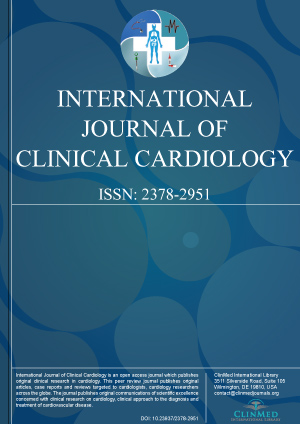Open Access DOI:10.23937/2378-2951/1410240
A Case Report of Pre-excited Atrial Fibrillation Encounters Ebstein's Anomaly: Is Amiodarone a Good Alternative Choice?
Hsiang-Wei Yang and Wai-Kin Wong
Article Type: Case Report | First Published: October 23, 2021
This is a case report of a 39-year-old man who presented to the emergency room with atrial fibrillation (AF), pre-excitation, and Ebstein's anomaly (EA). Currently, there was no suggestion of pharmacologic management if the patient declines surgical or catheter ablation therapy. A review of the literature concluded that amiodarone may be a suitable therapy for the pharmacological management of this patient. This 39-year-old man experienced occasional palpitations but on this occasion, the palpit...
Open Access DOI:10.23937/2378-2951/1410238
Correlation between Self-Reported Daily Activity and Submaximal Walk Test in the Assessment of Functional Capacity among Patients with Hypertension
Tolulope O Olatunbosun, MSc PT, Taofeek O Awotidebe, PT, PhD, Rufus A Adedoyin, PT, PhD, Olufesola M Fasakin, RN, MSc, Suraj A Ogunyemi, MBChB, FWACP, Abayomi A Olawoye, PT, DPT and Adekola J Odunlade, MSc, PT
Article Type: Original Article | First Published: September 13, 2021
Time constraint on the part of clinicians or musculoskeletal comorbidities in the lower limbs in some patients with hypertension may sometimes prevent submaximal walk test. Hence, self-reported activity thus becomes an alternative method for assessing quick functional capacity (FC). This study assessed FC using a self-reported daily activity tool; Duke Activity Status Index (DASI) and correlated its value with 6-Minute Treadmill Walk (6-MTW) among patients with hypertension. This cross-sectional...
Open Access DOI:10.23937/2378-2951/1410237
A Case of a Large Coronary Artery Fistula
Yevgeniy Latyshev, MD
Article Type: Case Report | First Published: September 11, 2021
Coronary artery fistulas are rare anomalies found during coronary angiography and non-invasive cardiac imaging. Recent advances in understanding of the pathophysiology allow more effective surgical and percutaneous treatments. It is important to recognize and treat hemodynamically significant fistulas when appropriate before ischemia and or heart failure occurs. We present a case of coronary artery fistula that was treated conservatively after a heart team discussion. Coronary artery fistulas (C...
Open Access DOI:10.23937/2378-2951/1410236
An Electrocardiographic Early Repolarization Pattern in a Competitive Athlete: Is it a Sign of Danger?
Daniel B Petrov, MD, FESC and Yoana D Petrova, M. Pharm
Article Type: Case Report | First Published: September 06, 2021
The 12-leads electrocardiogram (ECG), can play a key role in the diagnosis of ERP, and many pre-participation screening protocols include an ECG, because is it a simple, inexpensive initial tool in the evaluation a both symptomatic and asymptomatic athletes. In the setting of pre-participation screening appropriate differential diagnosis between physiologic and pathologic ST-segment elevation is of importance not only to prevent sport related sudden cardiac deaths (SCD), but also to avoid unnece...
Open Access DOI:10.23937/2378-2951/1410235
Appropriate Use and Outcomes of In-Hospital Telemetry: Implications Regarding the Contemporary Code Blue
Ronald F Espinosa, DO, Christopher A Woolley II, MD, Scot W Nolan, DNP, RN, Jill M Waalen, MD, MPH and Bruce J Kimura, MD, FACC
Article Type: Retrospective Cohort | First Published: September 03, 2021
Although practice standards for telemetry reflect the historical benefit of early monitoring for arrhythmias in select admissions, few data exist on the initial appropriateness of telemetry for contemporary inpatients who then later suffered a “code blue.” As telemetry monitoring is a significant resource, we sought to review appropriate use, detection of causative arrhythmias, and the timing and outcomes of telemetry use in code blues. Over a 3-year period in a 300-bed teaching hospital, da...

